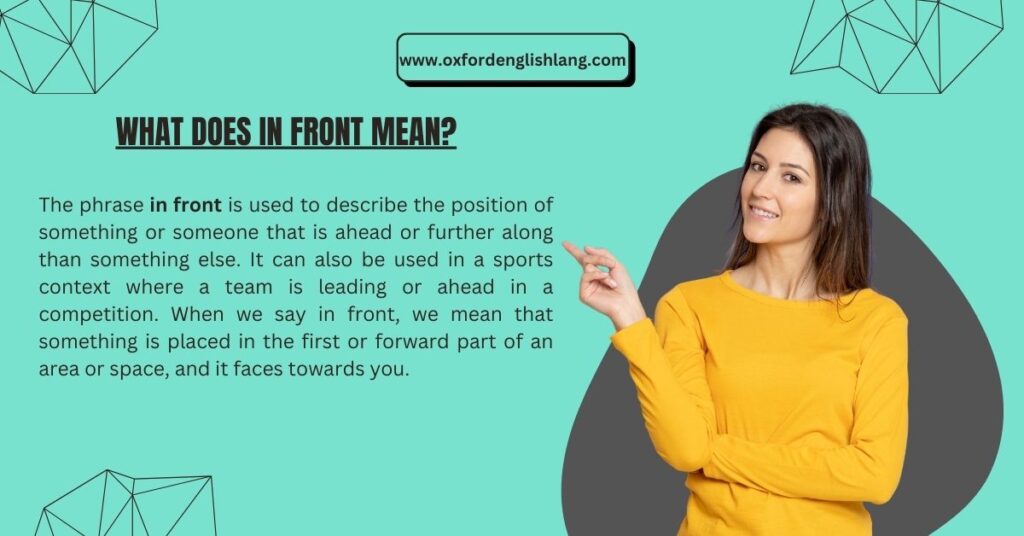When it comes to language, knowing how to use words the right way is important for clear communication. Whether you’re talking to people or writing an article, getting the details right can make a big difference. So, let’s check out the difference between infront and in front, and why it matters.
While some might think they are the same, the meaning behind these terms is subtle. The way we say them can change the message entirely. For example, in front is the correct version, but many still mistakenly use infront as one word.
Understanding these differences can help you improve your language skills and express yourself in a better way. By explaining these nuances, we can avoid confusion and make sure you don’t get stuck using the wrong term.
Infront or In Front: Which is Correct?
The term in front is the correct way to describe the position of something relative to another object or person. While infront is a common misspelling and non-standard, it doesn’t conform to English grammar rules.
Using the right form of in front helps ensure you’re communicating clearly, whether you’re describing something or someone positioned ahead of another object, before or on the side.
What Does In Front Mean?

The phrase in front is used to describe the position of something or someone that is ahead or further along than something else. It can also be used in a sports context where a team is leading or ahead in a competition. When we say in front, we mean that something is placed in the first or forward part of an area or space, and it faces towards you.
It’s a preposition that helps clarify the exact position of someone or something relative to another object. The correct spelling is in front, not infront, which is non-standard. Using this phrase in the right context makes things clear and easy to understand.
You Might also like: Greatful or Grateful: Master the Right Spelling
“In front” Sentence Examples & Phrases
The phrase “in front” is used to describe a position ahead of something or someone. It can fit into various contexts, from everyday situations to more descriptive scenarios. Below are some examples showcasing its usage:
- The artist stood confidently in front of the canvas, preparing a captivating masterpiece.
- A majestic oak tree stood in front of the house, casting a cool shadow.
- The car stopped abruptly in front of the intersection, causing a cyclist to swerve.
- The children waited eagerly in front of the school for the bus to arrive.
- A vibrant rainbow appeared in front of the mountains, creating a breathtaking scene.
- The statue stood proudly in front of the city hall, drawing admiration from visitors.
- The group gathered in front of the fireplace, sharing stories late into the night.
- The flag fluttered gracefully in front of the assembly during the morning ceremony.
- She stood in front of the mirror, practicing her speech for the event.
- The guide explained the history of ancient ruins while standing in front of the group.
- A curious cat perched in front of the window, watching squirrels and birds play outside.
- The trophy was placed in front of the collection of medals on the shelf.
- The banner was prominently displayed in front of the festival entrance.
- The rollercoaster line stretched far in front of the park gates, filled with excited people.
- A picnic blanket was laid in front of the lake, where ducks swam peacefully.
- Fireworks exploded beautifully in front of the crowd, lighting up the night sky.
- The theater entrance had a long queue in front, filled with eager moviegoers.
- The flowers in the garden in front of the house were blooming brightly.
- The mountains loomed majestically in front as the hikers drove closer.
- A dusty store sign was visible in front of the old market, adding to its mystery.
- The fireplace created a warm ambiance as the family sat in front of it.
- She knelt in front of him, holding a bouquet as a surprise proposal.
- The balloons floated freely in front of the stage, adding color to the event.
- The dogs barked loudly in front of the gate, guarding the house.
- A large banner waved proudly in front of the theater during the holiday festival.
Key Points About Using “Infront” or “In Front”
When it comes to writing, knowing the difference between in front and infront is crucial for clarity and professionalism. Here are some important points to keep in mind:
- In front is the correct and standard spelling for indicating a position ahead of something.
- Infront is considered a misspelling or non-standard variation of in front.
- Using in front maintains accuracy and consistency in writing.
- In front is commonly used to describe the position of an object relative to another.
- The correct spelling is important for clear communication and to avoid misinterpretation.
- Proofreading helps catch errors like using infront instead of in front.
- In front helps maintain credibility in professional or academic writing.
- Selecting the correct spelling ensures language precision and clarity.
- In front is a prepositional phrase that describes spatial relationships.
- Using in front instead of infront improves the effectiveness of your writing.
- The correct usage of in front enhances writing quality and consistency.
- In front helps avoid confusion in directions and narratives.
- Proper spelling reflects attention to detail and professionalism in your writing.
- Checking your writing for spelling mistakes, like infront, is essential for accuracy.
- In front is widely used in both formal and informal contexts.
- In front should be used when describing the location or position of something.
- Language precision is key, and using in front helps maintain it.
- Consulting a dictionary can confirm the correct usage of in front.
- In front aligns with established writing norms and rules.
- Being mindful of spelling ensures that your writing is clear and professional.
You Might also like: Sale vs Sell: Stop the Confusion Now!
Common Mistakes made by people using Incorrect spelling “ In front “
One common mistake people make is using infront instead of the correct spelling, in front. This error often happens because the words sound alike, but infront is not a real word.
Many individuals might use infront in informal writing, especially in social media posts, text messages, or emails, where brevity is more important than following strict grammar rules. This mistake can also occur in casual communication, where the focus is on speed, and people might quickly type without thinking about spelling.
Typographical errors or oversight may also cause this mistake, especially when people are typing fast and don’t pay attention to the correctness of their writing.
How to Avoid These Mistakes?
To avoid using infront, it’s important to remember that in front should always be written as two separate words. One way to prevent this error is to know the difference and make a conscious effort to avoid it in both professional and modern writing.
If you find yourself typing infront in informal settings, like text or social media, try to adopt the habit of proofreading your messages before sending them. Exposure to correct usage of in front in various contexts can help individuals evolve their writing habits over time.
Additionally, when writing in more formal situations, such as reports or essays, be sure to use the correct spelling to maintain professionalism.
You Might also like: Have Fun or Enjoy: The Powerful Difference Revealed
Conclusion
In conclusion, understanding the correct usage of in front versus infront is essential for clear, professional, and effective communication. By consistently using the standard spelling, you ensure that your writing is accurate, credible, and easy to understand. Whether in formal or informal settings, paying attention to spelling helps avoid confusion and enhances the overall quality of your content.
Always be mindful of language precision, and when in doubt, consult a dictionary or style guide to confirm the correct usage. By adhering to these simple rules, you can elevate your writing and convey your message with clarity and confidence.
FAQs
What is the difference between “Infront” and “In Front”?
The difference between “In Front” and “Infront” is mainly about correctness. “In Front” is the accurate and accepted spelling, used to describe something that is ahead of or before another object.
On the other hand, “Infront” is an incorrect form and should be avoided, as it’s not officially recognized in the English language. It’s considered a typographical mistake that doesn’t align with standard language rules.
How can “In Front” be defined?
“In Front” refers to a position that is located ahead of or before something else, either in terms of physical space or time. It’s a phrase used to indicate relative positioning, helping to clarify where one object or event stands in relation to another.
Can you give an example of when to use “In Front” in a sentence?
Here’s an example: “The in front row was filled with eager fans waiting for the concert to begin.” This shows the position of the row in relation to the rest of the seating.
What is the significance of using “In Front” in written communication?
Using “In Front” correctly in writing is crucial for clarity. It ensures that your message is easily understood and that the spatial relationships you describe are communicated accurately. Incorrectly using “Infront” can confuse the reader and make your writing seem less professional.
When might one mistakenly use “Infront” instead of “In Front”?
The mistake of using “Infront” instead of “In Front” often happens when people type quickly or are unaware of the proper spelling. It can also occur in informal communication, such as text messages or social media posts, where brevity is prioritized over strict adherence to spelling rules.

david Miller is an experienced English language expert with a deep passion for helping others communicate effectively and confidently. With a background in linguistics and literature, He provides clear, accessible insights on grammar, writing, and communication strategies. Through well-researched articles and practical advice, David Miller aims to make language learning both inspiring and achievable for readers of all levels.


